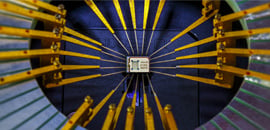Introduction
Proper shielding and grounding are essential to good servo design. Selecting the appropriate cable and devoting effort to the grounding of the encoder in the planning stage will save considerable time and expense in troubleshooting and correcting signal noise problems once the design is complete.
Shielding
A cable can transfer noise by acting as an antenna or it can pick up noise that is radiated from other equipment. Proper wiring and shielding can mitigate the effects of signal interference by reflecting it from the signal carrying wires and by conducting the interference to ground.
MicroE encoders feature double-shielded cables with twisted differential pairs. The inner shield is connected to circuit ground and the outer shield is connected to both the sensor and the connector housing. When the encoder is connected to ground, either at the sensor or at the connector, a path to ground for electrical noise is provided.
Cross-section of double-shielded cable











